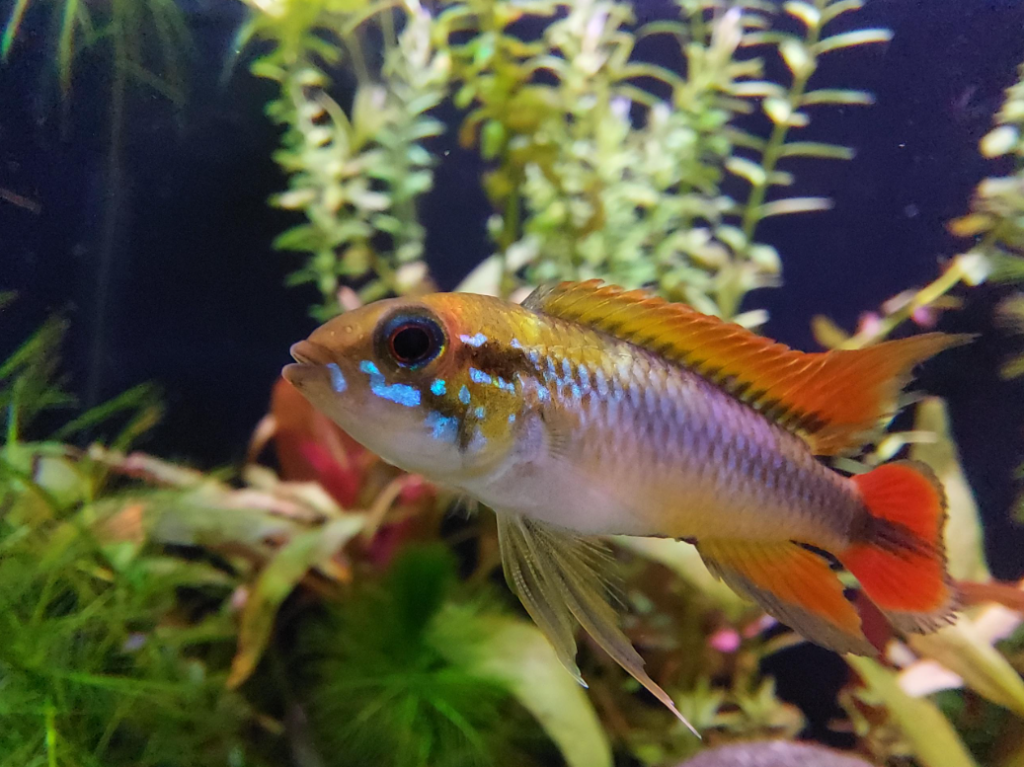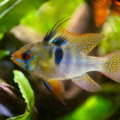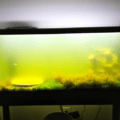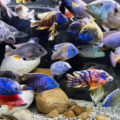Discover the best ways to care for your Apistogramma Agassizii and breed healthy freshwater dwarf cichlids with the informative tips in this guide!

In a world of colorful freshwater fish, the Apistogramma Agassizii stands out in vibrant colors and intricate patterns. Emerging from the Amazon basin in Peru and Brazil, this fish’s peaceful nature and suitability for planted aquariums have made it highly desired by aquarist.
You’ll need the right dwarf cichlid guide to make things work. I hear you loud and clear, and today, you’ll learn everything that Apistogramma Agassizi care entails. From setting up their tank and breeding healthy cichlids to extending their lifespan, it’s about to be a wild ride!
The Striking Appearance of Apistogramma Agassizii

At first glance, it’s clear that the Apistogramma Agassizii’s appearance is designed to satisfy your visual cravings. Despite the captivating brightness of these colorful dwarf cichlids, remember that their diet and tank conditions can make or mar their coloration (more on this later).
However, this bright color you see performs more than one function; I’ll help you understand how.
- Color Patterns: The radiant blue, red, and yellow hues of males and cooler patterns of dull yellow or brown on females are great ways of identifying Apistogramma species. When you spot this cichlid next, you know precisely which is which.
- Unique Traits: They have elongated trailing dorsal fins on their bodies and unique delta tails. They also display fierce, territorial behaviors, especially during the breeding season.
Setting Up the Ideal Tank

Next on the agenda is giving these beauties the home of their dreams. Creating the ideal aquarium for dwarf cichlids demands much effort, time, and creativity, and indispensable guidelines must be followed, especially regarding water health.
So, what does the right Apistogramma Agassizii tank setup look like? Don’t worry—the details are below.
Tank Size and Layout
This depends on your preference, but 20 gallons is a great number to start for a single pair. Increase your capacity to 30-40 gallons if you keep multiple pairs. Remember to leave some open areas for free swimming and install a gentle filtration system to clean up the water and keep the strong currents in check.
Water Conditions
| Water Temperatures | 72-84oF |
| pH Level | 5.0-7.0 |
| Hardness Level | 0-4 dKH for carbonate hardness, 2-10 dGH for general water hardness level |
| Ammonia, Nitrate and Nitrite | 0 ppm, <20 ppm, and 0 ppm, respectively |
Without proper water parameters maintained, the tank’s water quality can degrade, which can cause a wide range of issues from cloudy aquarium water to illness and mass fish die off.
Decor and Substrate
Adding extra detail isn’t just vanity; it actually increases comfortability in your fish tank and promotes natural behaviors, which are all great for Apistogramma Agassizii lifespan, more on this later.
Sandy substrate and decaying leaf litter imitate the riverbed in their natural Amazonian habitat – so throw them in.
Incorporate dense vegetation with live plants such as Java Fern, Swords, and Driftwood for hiding and breeding. The vegetation also breaks the line of sight in a community tank and helps control aggression.
These are all great ways to infuse natural habitat for Apistogramma inside your humble home tank. Turn your creative switch on!
Dietary Needs of Apistogramma Agassizii

Eating good food is life, and for these dwarf cichlids, this statement is a fact. Providing a diet for colorful fish like Apistogramma Agassizii requires various live, frozen meals and store-bought high-quality prepared foods.
Feeding Apistogramma Agassizii with balanced nutrition is vital for maintaining their health and sharpening their vibrant tones throughout the season.
Diet Suggestions
Bloodworms, brine shrimp, daphnia, and micro pellets are all great choices to include in dwarf cichlid nutrition. For extra mineral and color-preservation vitamins, you can also throw in blanched vegetables like cabbage, zucchini, and carrots.
For more on feeding your aquatic pets check out The Ultimate Guide to Fish Food: Pros and Cons & Best Choices!
Feeding Tips
You don’t want to overfeed your cichlids, keep the frequency between 2-3 times daily for adults.
Make sure you practice healthy portion control by supplying them with only what they can consume within 5 minutes.
Clear up food remnants right after to prevent water contamination and fish disease.
Breeding Apistogramma Agassizii: A Rewarding Challenge

Watching your pets multiply has got to be the most satisfying experience of all time for a hobbyist, but getting to that finish line requires hard work and consistency.
Breeding Setup
When breeding Apistogramma Agassizii, consider the water quality and immediate environment. For instance, these cichlids prefer slightly acidic water when spawning. The spawning Apisogramma species locate breeding caves where the female lays eggs on the cave wall and lets the male swim over them for fertilization.
Female Apistogramma Agassizi’s are incredibly protective of their eggs, and they will defend the cave by chasing away other fish, including the male.
Fry Care Tips
Feeding fry with infusoria during the first few days of their lives will supply them with essential nutrients necessary for growth.
Transition to baby brine shrimp 3-4 days after birth to build strong bones and boost their immune system.
Always remember raising dwarf cichlid fry must be done in a separate tank for optimum results and safety.
Compatible Tank Mates for Apistogramma Agassizii

Apistogramma Agassizii is a peaceful community fish with a temperament to match. This means they have embraced diversity in their immediate environment as long as their tank mates exhibit matching behaviors, exist in similar sizes, and operate on the same appetite bandwidth.
Now, I have curated a list of the perfect tank mates for Apiatogramm Agassizii and gone a step further by including the species to avoid due to their aggressive or territorial behaviors.
| Compatible Species | Incompatible Species |
| Small Tetras | Tiger Barbs |
| Peaceful Rasboras | Parachromis Managuensis |
| Otocinclus Catfish | Clown Loaches |
| Pencilfish | Fin-nipping species (Betta Splendens, Hyphessobrycon eques). |
That’s all about compatible species for dwarf cichlids. You’re welcome!
Preventing Health Issues in Apistogramma Agassizii
Although hardy, this cichlid can be sensitive to low water quality, unstable water parameters, and temperature. Here are a few Apistogramma Agassizii health tips for you.
Fungal Infection
Cause: Overcrowding, poor water quality
Symptoms: Discoloration, torn fins, white spots on skin
Treatments: Copper-based treatment and regular water changes should be included in dwarf cichlid health care.
Cause: Lack of hiding spots, sudden changes in water temperature, poor filtration, incompatible tank mates
Symptoms: Reduced desire to breed, irregular swimming patterns, appetite reduction, loss of color
Treatments: To secure the fish environment, rehome aggressive tank mates, regulate water parameters, and introduce hiding spots.
Signs of Illness: Keeping a close eye on symptoms like faded colors, lethargy, and rapid grill movement is great for preventing cichlid diseases.
Extending the Lifespan of Apistogramma Agassizii

Apisogramma Agassizii can live up to 10 years in an aquarium, offering vibrancy and positive energy for a long time. But to whom much is given, much is expected—in a nutshell, proper care, a balanced diet, and a stress-free environment all significantly contribute to extending its lifespan. With that being said, settle in for some helpful Apistogramma Agassizii lifespan tips.
Lifespan Factors
A healthy aquarium fish care starter pack begins with ticking these three items off your list:
- Clean water with healthy parameters to prevent disease outbreak
- Proper tank mates to aid a healthy social environment in your aquarium
- Nutrient-rich diet to promote growth and sustain vibrant coloration.
Care Tips for Longevity
As a hobbyist dedicated to long-term care for dwarf cichlids, it’s important to schedule regular maintenance (water changes, removal of food remnants from the tank), notice disease symptoms early, and ultimately control disease spread.
Conclusion
Your colorful aquarium fish care journey begins here, and creating a natural habitat is vital to unlocking this species’ full potential and beauty! If you need help preserving their vibrant colors, managing their sometimes aggressive temperament, and enhancing their adaptability, this complete dwarf cichlid guide has you covered.
Here’s a summary of everything I’ve covered in this Apistogramma Agassizii care guide to help you on the road to hobbyist bliss.
Getting the tank setup right is a cogent part of the journey.
Prevention is better than cure – early detection and treatment go a long way in your fish’s health.
Breeding is vital to keeping the Apisogramma Agassizii ecosystem running. Maintain healthy water parameters at all times and prioritize fry care.










